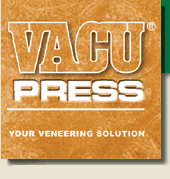Don Stephan

Posts: 825
Joined: 2003-07-18
Location: Cincinnati, Ohio
 User Profile User Profile |
Over the last couple days I've spent a number of hours comparing and contrasting two descriptions of methods for making diamond matches. One is from "The Complete Manual of Wood Veneering" by W. A. Lincoln (and repeated by Kim Carleton Graves in his book "Dining Tables." The other method is in a March 1995 "Fine Woodworking" article by Frank Pollaro.
Shame on me, it was only after hours of comparison that I make a very fundamental discovery - they don't produce the same results. The Lincoln method essentially builds 4 matching snmall squares of diagonal grain, which combine to make a large square. If a clock face is overlaid on the large square, the diamond has the diagonal grain running from 12 to 3, from 3 to 6, from 6 to 9, and from 9 to 12. The reverse diamond has the grain running from the center of the large square out to its four corners. The Pollaro article also talks of making diamond and reverse diamond patterns, but to my mind they might more accurately be called cross and square patterns. The Pollaro method builds four isosceles triangles (think of a square cut by lines connecting opposing corners) the hypotenuse of each forming one side of the (large) square. His "cross" has the grain perpendicular to the hypotenuse of each isosceles triangle, and his "square" has the grain parallel to the hypotenuse of each isosceles triangle.
Besides the fact that they produce dramatically different grain directions in the resulting large square, and accordingly dramatically different looks, there seem to be advantages and disadvantages of each.
The Lincoln method requires very precise preparation and cutting if the various sub-assemblies are to fit together tightly without re-cutting. However, both the diamond and reverse diamond are made the exact same way, and after completion each can easily be converted to the other by splitting the large square along the horizontal or vertical center line and putting the former common edges on the outside of the new large square.
The Pollaro method requires far less accuracy in cutting the sub-assemblies, the resulting "cross" and "square" are more dramatic or bolder than the Lincoln diamond and reverse diamond. However, the "cross" cannot be converted after completion into a "square" and vice versa.
The Lincoln diamond and reverse diamond both start with four "sheets" three times as long as wide. Likely these "sheets" are in fact built-up or "prime" sheets of individual narrower sheets of veneer. Many might feel the diamond and reverse diamond look best with very regularly repeated parallel grain, so these "prime" sheets can be built using either slip or bookmatching, and it wouldn't matter if the "prime" sheets consisted of an even or odd number of individual sheets.
As I interpreted the article, the Pollaro "cross" begins with four "prime" sheets twice as wide as they are long, and the obtain the most dramatic "cross" these "prime" sheets should consist of an even number of bookmatched individual sheets. The Pollaro "square" begins with four "prime" sheets twice as long as wide, and the "prime" sheets can be built using either slip or bookmatching with either an even or an odd number of individual sheets. Many might feel the Pollaro results would look better (be more dramatic) if there is some irregularity in the individual sheets making up the "primes" such as an occasional wider band of grain.
The Lincoln method produces less waste, one-third of the four "prime" sheets, while the Pollaro method wastes one half the four "prime" sheets.
Before I look for some practice (i.e. inexpensive) veneer to try the Lincoln and Pollaro methods, has anyone else compared them? Has anyone used either of the two methods alone? I'd greatly appreciate confirmation of my assumptions of correction of errors.
(I'd have liked to produce some graphics to show the details of the two methods, but don't know how to produce the look of grain in TurboCad and question how meaningful simple drawings without grain would be.)
Thanks.
Don Stephan
|






